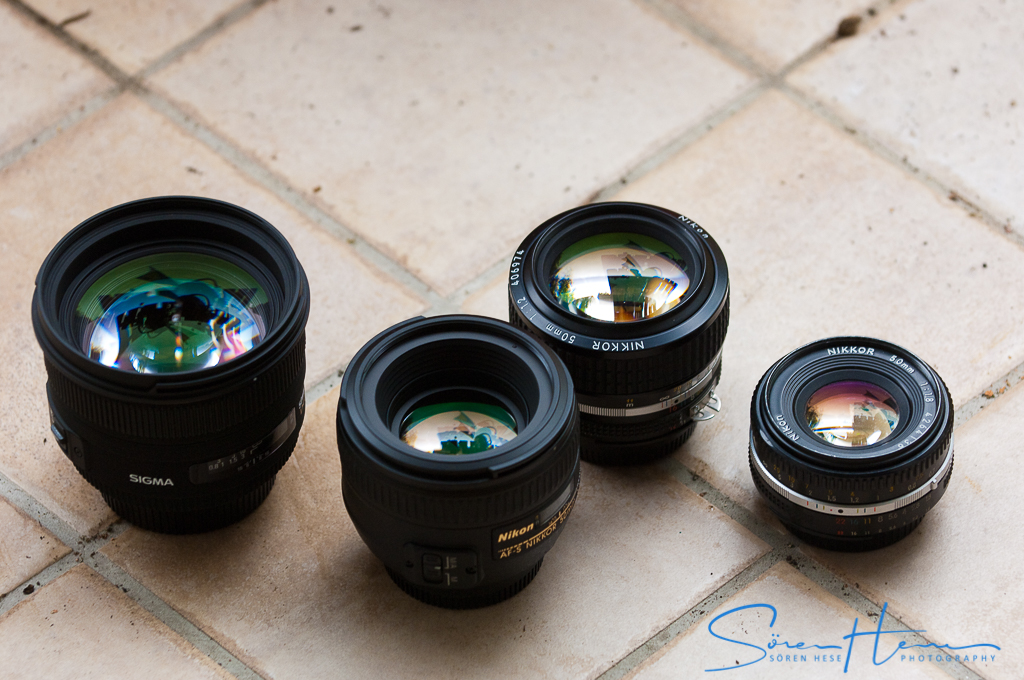50 mm Bokeh Contest for the Nikon F-Mount
50 mm Bokeh Contest for the Nikon F-Mount
Here comes a gear centric contribution:
From left to right: Sigma 50 mm f1.4 EX DG HSM, Nikkor AFS 50 mm f1.4 G, Nikkor AIS 50 mm f1.2, Nikkor AIS 50 mm f1.8
The 50 mm lens has been a popular choice for portraits with APS-C sensor cameras and for low light photography in general. For Nikon based photographers the AF-D version of the 50/1.4 was long overdue for an update when Nikon introduced the AF-S G type version with a fresh and new lens design.
Lets summarize: mapping the market for a 50 mm for a while the only AF alternatives for the Nikon F-mount right now are:
1. the new Nikkor 50 mm AFS f1.4G,
2. the old D-type Nikkor 50 mm AF 1.4D,
3. the D-type Nikkor 50 mm AF f1.8D and
4. the Sigma AF 50 mm f1.4 EX DG HSM.
For manual focus lenses there are more alternatives around. Usually with these low light and minimal DOF lenses you do want an AF option.
Of the 4 AF lenses 2 have an ultrasonic ring engine for focusing. So lets concentrate on these two concepts. The Sigma 50 f1.4 EX DG HSM and the Nikon AFS 50 mm f1.4G are the most recent developments. There are rumours floating around of a new Nikon f1.2 AFS version to be released soon (might never happen – but who knows).
Sigma did put some effort into redesigning the 50 mm so it will be interesting to see how the Sigma compares to the Nikon. This lens comparison will primarily focus on some often not described characteristics of these lenses: out of focus properties or often labelled “bokeh” characteristics. There are some other important aspects to consider when one decides which lens to buy. Sharpness and focus accuracy comes to mind. But my primarily concern was how the out of focus areas look like in these lens designs. The Sigma received lots of praise for its bokeh in various comments and net reviews – so this lens seems to be a clear option for portraits, weddings and child photography.
The Sigma is a huge lens compared with the usual lens size in this class. The front element is close in size to the Nikon 85 f1.4 AF-D but the hefty feeling of this lens makes the lens/camera combo just feel right – especially with larger Nikon DSLR bodies the Sigma seems to be just right in size and weight. And that should be mentioned: the lens just looks somehow good with this massive amount of glass (was just wondering why I hesitate to name it: the lens looks sexy! here we go). The lens comes with the typical Sigma surface finish. This crinkle paint seems to attract dust and dirt but the grip with this lens is perfect.
The AF with my Sigma sample was constantly back focusing on close and far range objects (could be corrected with a focus calibration enabled camera body). The Nikon sample that I used is doing much better here. AF is nearly always spot on – but the Nikon AF is much slower than the Sigma HSM AF system. If you need a fast AF than the Nikkor is not the lens for you. The AF just doesn’t “snap” to its focus point and seems slow and sluggish. The Sigma is more responsive here and the quick lock on objects makes fun. The Sigma seems however to miss the precise focus point more often.
Resolution figures are not my main interest with these lenses. If you want to know more about MFT etc. than check the DPReview pages about both lenses:
DPReview Nikkor 50 mm AFS G f1.4
DPReview Sigma 50 mm DG HSM f1.4 .
One aspect that is rarely tested is the quality of the OoF highlights and the quality of the bokeh of these two lenses. This is a property that is difficult to measure and also subjective.
The Sigma has a very two-sided character here. It renders the out of focus objects with better (smoother) bokeh than the Nikkor – the style has a painting like finish – but this is only true as long as your out of focus area has no strong highlights.
Below: Sigma 50 mm f1.4 EX DG HSM, Above: Nikkor AFS 50 mm f1.4 G
This makes the problem more obvious:
Read the full review here:
